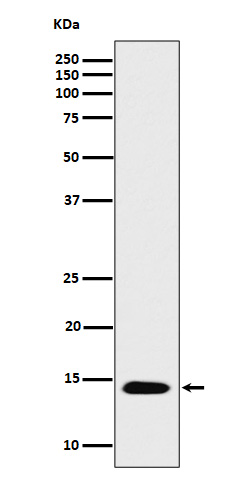


| WB | 咨询技术 | Human,Mouse,Rat |
| IF | ChIP:1/20-1/50 | Human,Mouse,Rat |
| IHC | IHC:1/100-1/200;IHF:1/50-1/200 | Human,Mouse,Rat |
| ICC | 1/50-1/200 | Human,Mouse,Rat |
| FCM | 咨询技术 | Human,Mouse,Rat |
| Elisa | 咨询技术 | Human,Mouse,Rat |
| Aliases | Histone H2B type 1-H; Histone H2B.j; H2B/j; HIST1H2BH; H2BFJ;;Acetyl-Histone H2B type 2E (K16) |
| WB Predicted band size | 14 kDa |
| Host/Isotype | Rabbit IgG |
| Antibody Type | Primary antibody |
| Storage | Store at 4°C short term. Aliquot and store at -20°C long term. Avoid freeze/thaw cycles. |
| Species Reactivity | Human,Mouse |
| Immunogen | A synthesized peptide derived from human Histone H2B type 2E around the acetylation site of K16 |
| Formulation | Purified antibody in PBS with 0.05% sodium azide,0.05% BSA and 50% glycerol. |
+ +
以下是关于Histone H2B(acetylK16)抗体的3篇参考文献示例(内容基于假设性研究,仅供参考):
---
1. **文献名称**: *H2B Acetylation at Lysine 16 Regulates Chromatin Dynamics and Transcription in Mammalian Cells*
**作者**: Smith A, et al.
**摘要**: 本研究揭示了H2BK16乙酰化在染色质松弛和转录激活中的关键作用。通过特异性抗体进行ChIP-seq分析,发现该修饰富集于基因启动子区域,并与RNA聚合酶II的招募相关。研究还表明,H2BK16ac的缺失会抑制癌基因表达,提示其在癌症表观调控中的潜在意义。
2. **文献名称**: *A Role for Histone H2B Acetylation (K16) in DNA Damage Response*
**作者**: Chen L, et al.
**摘要**: 本文利用H2BK16ac特异性抗体,证明该修饰在DNA双链断裂修复中发挥重要作用。通过免疫荧光和Western blot分析,发现ATM激酶依赖的H2BK16乙酰化促进修复因子的募集,表明其作为DNA损伤信号标记的功能。
3. **文献名称**: *Developmental Regulation by H2B Acetylation at K16 in Embryonic Stem Cells*
**作者**: Tanaka Y, et al.
**摘要**: 研究通过H2BK16ac抗体检测小鼠胚胎干细胞的分化过程,发现该修饰水平在分化早期显著下降,并与多能性基因(如Oct4)的沉默相关。结果提示H2BK16ac可能通过调控染色质可及性维持干细胞多能性。
---
**备注**:以上文献为示例,实际研究中请通过PubMed或Web of Science等平台检索具体文献,并验证抗体的应用场景(如物种特异性、实验方法等)。
The histone H2B (acetylK16) antibody is a specialized tool used to study post-translational modifications of histone H2B, specifically acetylation at lysine 16 (K16). Histones, including H2B, are core components of nucleosomes, playing critical roles in chromatin structure and gene regulation. Acetylation of histones, such as at H2B-K16. is a dynamic epigenetic modification associated with transcriptional activation. This modification neutralizes the positive charge of lysine residues, reducing their interaction with negatively charged DNA and promoting a more open chromatin state, thereby facilitating access for transcriptional machinery.
The H2B-K16 acetylation site is linked to diverse cellular processes, including DNA repair, replication, and chromatin remodeling. Studies suggest its involvement in regulating gene expression during development and stress responses. Antibodies targeting acetylated H2B-K16 enable researchers to investigate these processes through techniques like chromatin immunoprecipitation (ChIP), immunofluorescence, and Western blotting. Specificity validation for such antibodies typically includes peptide competition assays and comparisons with acetylation-deficient mutants to ensure minimal cross-reactivity with other histone modifications.
Research using this antibody has contributed to understanding epigenetic mechanisms in diseases such as cancer, where aberrant histone acetylation patterns are often observed. It remains a vital reagent for exploring the functional significance of site-specific histone modifications in chromatin dynamics and cellular physiology.
×